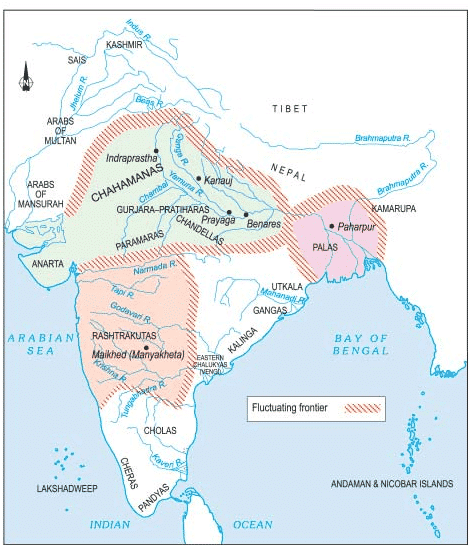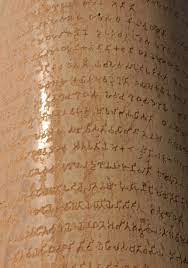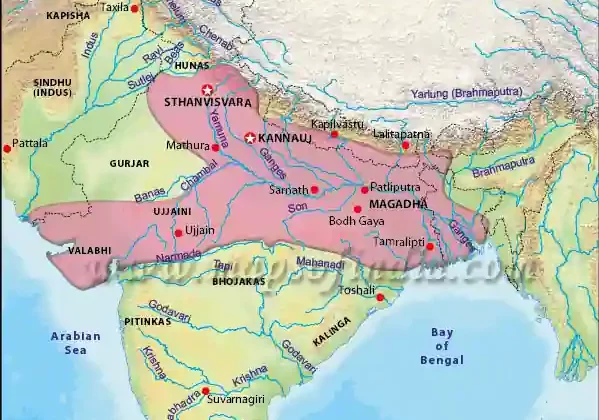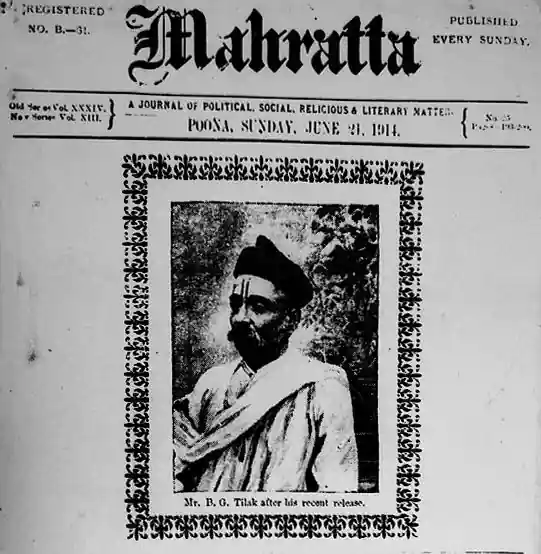Life Of Gautam Buddha
The life story of the Buddha begins in Lumbini, near the border of Nepal and India, about 2,600 years ago, where the man Siddharta Gautama was born. Gautam Buddha founded Buddhism and is known as Supreme Buddha or ammāsambuddha or samyaksaṃbuddha.
Early Life
- He was born in Lumbini, a little principality of Kapilvastu in modern day Nepal. His childhood name was Siddhartha.
- He was son of Shuddodhana a leader of the Shakya clan.
- The capital of this Sakya clan was Kapilvastu and it was not a monarchy but a sort of Republic.
- Queen Mahamaya was the name of mother of Gautam Buddha. Hathras district of Uttar Pradesh was renamed as “Mahamaya Nagar”, after Buddha’s mother.
- The birth of Buddha is celebrated as Vesaka in some countries. In India, it is Buddha Purnima.
- Queen Mahamaya died soon after his birth and Maha Prajapati or Prajapati Gautami raised him. He was a prince so he had lived his early childhood in luxury.
- His father wished him to be a great king and so he was shielded from the religious teachings or human sufferings. However, as a child Gautama used to be absorbed in philosophical musings.
- He got married at the age of 16 with Yashodhara. She gave birth to a Son, Rahula.
Four Signs
According to Buddhist texts, a prophecy was given at Siddhartha’s birth that he would become either a powerful king or great spiritual leader. His father, fearing he would become the latter if he were exposed to the suffering of the world, protected him from seeing or experiencing anything unpleasant or upsetting for the first 29 years of his life. One day (or over the course of a few) he slipped through his father’s defenses and saw what Buddhists refer to as the Four Signs:
- An aged man
- A sick man
- A dead man
- A religious ascetic
Through these signs, he realized that he, too, could become sick, would grow old, would die, and would lose everything he loved. He understood that the life he was living guaranteed he would suffer and, further, that all of life was essentially defined by suffering from want or loss. He therefore followed the example of the religious ascetic, tried different teachers and disciplines, and finally attained enlightenment through his own means and became known as the Buddha (“awakened” or “enlightened” one). Afterwards, he preached his “middle way” of detachment from sense objects and renunciation of ignorance and illusion through his Four Noble Truths, the Wheel of Becoming, and the Eightfold Path to enlightenment.
Buddha’s enlightenment
- At the age of 29, while going to meet his subjects he encountered human sufferings such as old age, death and diseases. He used to ask his charioteer Channa about these sufferings. He deeply depressed by the truth that human life is momentary and one has to suffer a lot.
- He left his home at the age of 29 years, so that he could overcome old age, illness and death by living a life of an ascetic. This is called “the great departure’ or Mahabhinishkramana”.
- He first went to Rajgriha Rajgaha or Rajgir. He started begging alms over there and living life of an ascetic. The King Bimbisara after a request from Shuddodhana, launched a search and Siddhartha was recognized by the men of Bimbisara. Bimbisara offered him a throne, but Gautama refused. He left Rajgir but promised Bimbisara to visit his capital Magadha, later.
- Siddartha studied under two hermits Alara and Udaka. He achieved high knowledge and was asked to succeed Udaka, but he was not satisfied with the path and his goal so he refused.
- The experiments with the life of ascetics could not bring desired fruits for Gautama. He left the Udaka, and moved on with 5 companions who were led by Kaundinya. They set out for more austerity. They tried enlightment through total deprivation of possessions including food. This led him to starving near death condition, and one day he collapsed into a river and almost drowned. This led him to reconsider the path. He started moving away from ascetics and moving closer to meditating and this is called the Middle Path, the path of having oneself away from extreme self-indulgence and extreme self-mortification.
- He accepted milk and rice pudding from a village girl called Sujata, who mistakes him for a tree spirit because he is so emaciated, and offers him some rice milk. The milk revives him, and he ends his asceticism and goes to nearby village of Bodh Gaya where he seats himself on a bed of grass beneath a Bodhi tree and vows to remain there until he understands the means of living without suffering.
- While meditating under a Pipal tree on the bank of river Niranjana at Gaya, he came across the desired truth, at the age of 35 years and after 49 days of meditating. He was now called Buddha or “Shakyamuni Buddha” which means the Buddha of Shakya Clan.
Disciples of Buddha
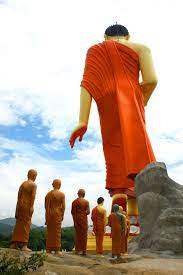
- The first disciples of Buddha after becoming enlightened were two merchants named Tapussa and Bhallika. After becoming enlightened, he sought to find his former teachers Arada and Udaka to teach them, but they had died. He then looked for Kaundinya and other companions.
- Gautama Buddha now preached his first sermon which deals with the Four Noble Truths and the Noble Eightfold Path, the core pillars of Buddhist teaching regarding the intrinsic suffering of existence and how to deal with it. This was called Dhammacakkappavattana Sutta. Kaundinya & 4 others became the first human beings to be taught Buddha ‘s teaching and become an arhat (spiritual practitioner). This event took place at Deer Park near Varanasi.
- Two gems of Buddhism viz. Buddha and Dhamma were now ready. The five disciples and Buddha formed the first union of Buddhism, which is called Sangha. So, with the formation of a Sangha, the three gems of Buddhism (Buddha, Dhamma and Sangha) were completed. The reaming years of life, Buddha travelled many parts of the country, established the Sangha, and propagated his teachings. Thousands of people joined Sangha and these Sanghas spread in many parts. As promised previously Buddha now travelled to Magadha, the capital of King Bimbisara. During this visit Sariputta(who later founded Theravada tradition) and Mahamoggallana became Buddha’s disciples. Sariputta, Mahamoggallana, Mahakasyapa, Ananda and Anuruddha comprised the five chief disciples. His ten foremost disciples were completed by the quintet of Upali, Subhoti, Rahula, Mahakaccana and Punna. Rahula was his son, who became disciple at the age of 7.
- Buddha’s parinirvāṇa happened at Kuśinagara at the age of 80 years.
Tenets & Teachings
Although he could now live his life in contentment and do as he pleased, he chose instead to teach others the path of liberation from ignorance and desire and assist them in ending their suffering. He preached his first sermon at the Deer Park at Sarnath at which he introduced his audience to his Four Noble Truths and the Eightfold Path. The Four Noble Truths are:
- Life is suffering
- The cause of suffering is craving
- The end of suffering comes with an end to craving
- There is a path which leads one away from craving and suffering
The fourth truth directs one toward the Eightfold Path, which serves as a guide to live one’s life without the kind of attachment that guarantees suffering:
- Right View
- Right Intention
- Right Speech
- Right Action
- Right Livelihood
- Right Effort
- Right Mindfulness
- Right Concentration
By recognizing the Four Noble Truths and following the precepts of the Eightfold Path, one is freed from the Wheel of Becoming which is a symbolic illustration of existence. In the hub of the wheel sit ignorance, craving, and aversion which drive it. Between the hub and the rim of the wheel are six states of existence: human, animal, ghosts, demons, deities, and hell-beings. Along the rim of the wheel are depicted the conditions which cause suffering such as body-mind, consciousness, feeling, thirst, grasping among many others which bind one to the wheel and cause one to suffer.ONE CAN STILL ENJOY ALL ASPECTS OF LIFE IN PURSUING THE BUDDHIST PATH, ONLY WITH THE RECOGNITION THAT THESE THINGS CANNOT LAST.
In recognizing the Four Noble Truths and following the Eightfold Path, one will still experience loss, feel pain, know disappointment but it will not be the same as the experience of duhkha, translated as “suffering” which is unending because it is fueled by the soul’s ignorance of the nature of life and of itself. One can still enjoy all aspects of life in pursuing the Buddhist path, only with the recognition that these things cannot last, it is not in their nature to last, because nothing in life is permanent.
Buddhists compare this realization to the end of a dinner party. When the meal is done, one thanks one’s host for the pleasant time and goes home; one does not fall to the floor crying and lamenting the evening’s end. The nature of the dinner party is that it has a beginning and an ending, it is not a permanent state, and neither is anything else in life. Instead of mourning the loss of something that one could never hope to have held onto, one should appreciate what one has experienced for what it is – and let it go when it is over.
Conclusion
Buddha called his teaching the Dharma which means “cosmic law” in this case (not “duty” as in Hinduism) as it is based entirely on the concept of undeniable consequences for one’s thoughts which form one’s reality and dictate one’s actions. Today, the efforts of Siddhartha Gautama are appreciated worldwide by those who have embraced his message and still follow his example of appreciating, without clinging, to the beauty of life.
Also refer :


